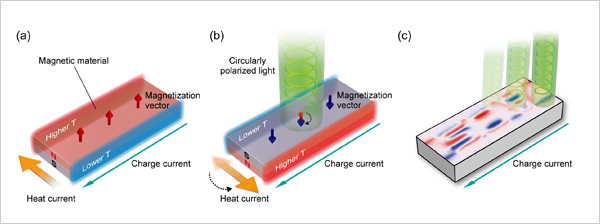Simple, Flexible Optical Manipulation of Charge Current-Induced Heat Flow
—Novel Thermal Energy Control Mechanism Using Electron Spin, a Source of Magnetism—
2020.01.08
National Institute for Materials Science (NIMS)
Japan Science and Technology Agency (JST)
NIMS demonstrated for the first time that the direction and distribution of a charge-current-induced heat flow in a magnetic material can be controlled freely by simply illuminating the material with visible light. This technique may be used to actively manipulate thermal energy in magnetic materials and may be applicable to the development of thermal management technologies vital to nanoscale electronic devices. This result may also deepen knowledge of the interaction between magnetism, heat and light.
Abstract
- NIMS demonstrated for the first time that the direction and distribution of a charge-current-induced heat flow in a magnetic material can be controlled freely by simply illuminating the material with visible light. This technique may be used to actively manipulate thermal energy in magnetic materials and may be applicable to the development of thermal management technologies vital to nanoscale electronic devices. This result may also deepen knowledge of the interaction between magnetism, heat and light.
- The conversion of a charge current into a heat current and vice versa occurs in metals and semiconductors in what is called the thermoelectric effect. For example, a heat flow can be generated by a charge current in accordance with Peltier effect, a representative thermoelectric effect discovered in 1834. The direction of a Peltier-effect-induced heat flow is generally determined by the type of material used. However, in the case of magnetic materials, the direction of a charge-current-induced heat flow can be manipulated by the properties of electron spin, a source of magnetism. Recent advances in spin control technologies have rapidly intensified global research efforts in “spin caloritronics” with the aim of discovering new principles and functions that enable effective thermal energy utilization using electron spin.
- The NIMS research team focused on magneto-optical recording techniques—previously considered entirely irrelevant to spin caloritronics—and succeeded in developing a new thermal energy control technique that uses light to control electron spin. This technique is capable of locally changing the direction of a charge-current-induced heat flow in the part of a magnetic material illuminated with light. Changes in the direction of the heat flow depend on the polarization state of the light illuminated. This technique enables the thermoelectric-effect-induced temperature distribution in a material to be manipulated freely.
- The physical phenomenon observed in this experiment was driven by the interaction between magnetism, heat and light, which is a different principle from the conventional Peltier effect. In future studies, the team plans to investigate the microscopic origins of the thermoelectric effect exhibited by optically responsive magnetic materials and develop new materials applicable to the development of thermal management technologies capable of increasing electronic devices’ energy efficiency.
- This project was carried out by Ken-ichi Uchida (Group Leader of the Spin Caloritronics Group, Research Center for Magnetic and Spintronic Materials (CMSM), NIMS), Yukiko K. Takahashi (Group Leader of the Magnetic Recording Materials Group, CMSM, NIMS) and Jian Wang (ICYS Research Fellow, International Center for Young Scientists, NIMS).
This work was supported mainly by the JST Strategic Basic Research Program CREST (project number: JPMJCR17I1). - This research was published in Nature Communications, an open access British scientific journal, at 7:00 pm on January 7, 2020, Japan Time (10:00 am on January 7, GMT).

figure: Thermoelectric conversion controlled by the illumination of light
Related files
- Research Center for Magnetic and Spintronic Materials
- ICYS
Contacts
(Regarding this research)
-
Ken-ichi Uchida
Group Leader,
Spin Caloritronics Group,
Research Center for Magnetic and Spintronic Materials,
National Institute for Materials Science (NIMS)
Tel: +81- 859-2062
FAX: +81-029-859-2701
E-Mail: UCHIDA.Kenichi=nims.go.jp
(Please change "=" to "@")
(General information)
-
Public Relations Office
National Institute for Materials Sciences
Tel: +81-29-859-2026
Fax: +81-29-859-2017
E-Mail: pressrelease=ml.nims.go.jp
(Please change "=" to "@") -
Public Relations Division
Department of General Affairs
Japan Science and Technology Agency
Tel: +81-3-5214-8404
Fax: +81-3-5214-8432
E-Mail: jstkoho=jst.go.jp
(Please change "=" to "@")
(Regarding the JST Strategic Basic Research Programs)
-
Tsuyoshi Nakamura
Green Innovation Group, Department of Strategic Basic Research
Japan Science and Technology Agency
Tel: +81-3-3512-3531
Fax: +81-3-3222-2066
E-Mail: crest=jst.go.jp
(Please change "=" to "@")
Same Keywords
-
Development of a Novel Thermoelectric Material with Conversion Efficiency as High as Bi2Te3
(Thermal,JST)
2021.04.17
-
Proof-of-principle demonstration of 3-D magnetic recording
(JST)
2024.03.27
-
Exceptionally Large Transverse Thermoelectric Effect Produced by Combining Thermoelectric and Magnetic Materials
(spin caloritronics)
2024.03.07
Recent Press Release
-
Multiple Autonomous AI Systems Spontaneously Collaborate to Advance Materials Research
2025.12.10
-
Simultaneous Imaging of Intracellular DNA and RNA Using Harmless Light
2025.10.27
-
Development of an AI Device Using Ion Gel and Graphene That Dramatically Streamlines Machine Learning Computations
2025.10.14
